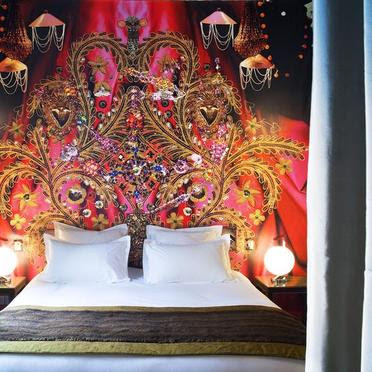
Chinoiserie by Francois Boucher
I have a small obsession with all things chinoiseried. The bold, saturated colours combined with the elegance and whimsy of rococo result in well, bold beautiful elegance! I have often seen similarities between the palette of Mexico and South America with that of China, but here these exotic features have been re-assembled to suit the grand tastes of the European aristocracy. Chinoiserie reached its peak in popularity around the mid-18th century with palaces and garden follies, country estates and whole purpose-built villages transformed by the asymmetrical whimsy and romance of the Euro-Chinese aesthetic.

The Chinese began painting landscapes, birds, flowers and figures of history on long strips of silk in the 1600s. Mounted on sheets of rice paper, these panels were used as wallpaper or framed for the wall. By the 17th century the East India Company opened up trading routes between the far east and Europe, bringing with them objets de art, porcelain, lacquered furniture and other collectibles. The aesthetic was adapted by European artists to create interiors and especially silk wall panels inspired by the Orient rooted in the current fashions of the time. These panels were often hung side by side to create stories and a wallpaper effect. The style was particularly favoured by King Louis XVI and his court and in 1785 the French invented a paper printer that increased the variety and availability of designs by local artists.

The house of De Gournay here in London has continued to turn out exquisite hand-painted wallpapers, fabrics and indeed whole interiors in the tradition of the chinoiserie of the 18th - early 19th centuries. Any of their designs may be adapted colour or design-wise, and they really get me itching to do my own rather more naive take on them in the form of murals or perhaps even on paper banners. The image above and those below all feature the glorious De Gournay, and they sum up for me what vast sums of money combined with artistic talent can achieve...

A little gold to get your imagination blazing, if you will.




See? Mexico and China have things in common... hot pinks and verdant greens, sunny yellows too...


Oh just one panel would do me! Look at that! Time to get painting. Gorgeous.

Each time I grit my teeth at the bareness of my bathroom walls I see a school of these ghost-like graceful fishes wavering across the white expanses. Oh what I would do to gaze upon this silvery underwater haven from my bathtub.

These two rooms sum up the two moods of chinoiserie perfectly. Ethereal, serene, soothing and contemplative above; bold, vibrant, lively, happiness-inducing, bright brilliance below. One for meditating and writing in a fabulous silk-bound diary with a long quill and emerald ink, the other for dancing madly in layers of vivid Chinese gowns, peonies strewn across the parquet flooring, kumquats in careless piles and copper fountains singing. I was recently told a story of a lady who inhabited the largest room in England. She had parrots and birds of paradise flying in the vast height of the ceiling. That's the sort of palace I'd have...











































